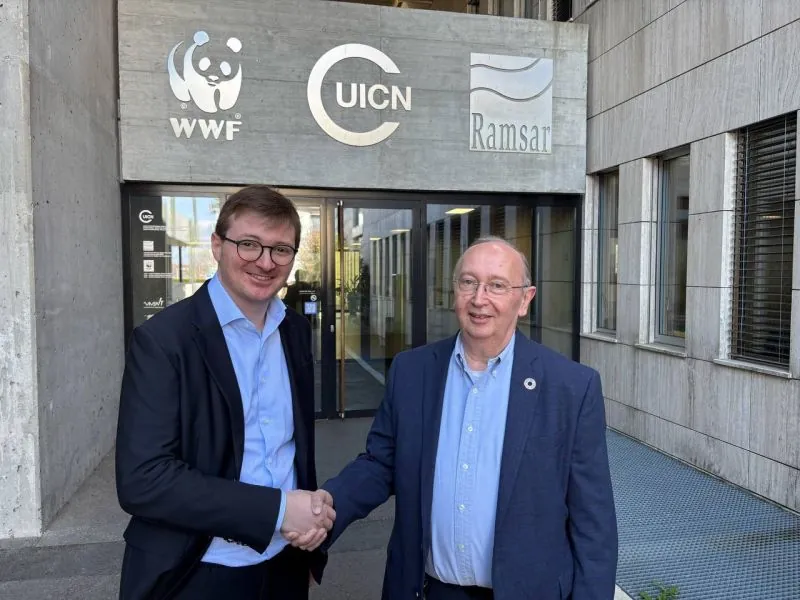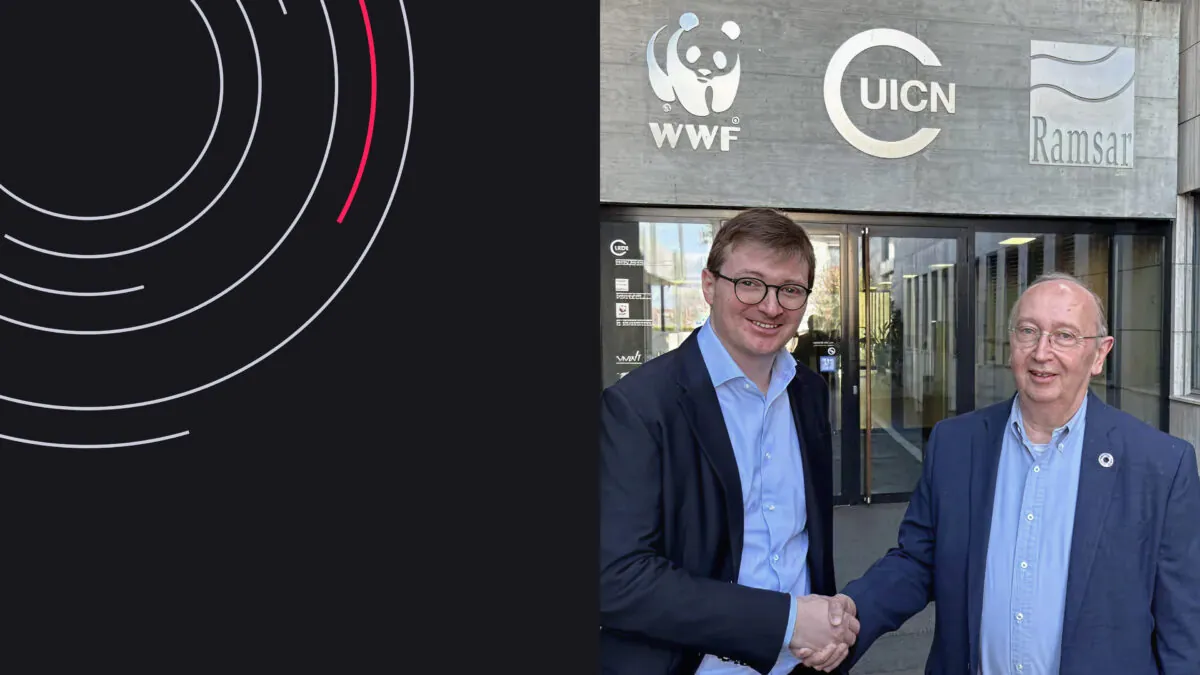Technology won’t save the planet. People will.
Still, the way we use technology can tip the balance. For Environmental NGOs, artificial intelligence is no longer an experiment — it’s a quiet force helping them protect nature, track wildlife, and understand fragile ecosystems faster than ever before.
This story begins with one of the world’s oldest and most respected organizations working for the environment — the International Union for Conservation of Nature, or simply, IUCN.
Inside IUCN: Nature’s Voice at the UN
Founded in 1948, IUCN is often called “nature’s voice at the UN.” It’s the world’s largest environmental organization — a democratic union that brings together over 1,500 governmental bodies, NGOs, and Indigenous peoples’ organizations across more than 160 countries.
Its vision is simple yet powerful:
A just world that values and preserves nature.
And its mission reminds us what this work really means:
To influence, encourage and assist societies around the world to conserve the integrity and diversity of nature, and to ensure that any use of natural resources is equitable and ecologically sustainable.
Behind these words stands a vast network — 17,000 scientists and volunteers, 1,200 staff members, and projects spanning more than 140 countries. The structure is impressive: seven commissions, 11 regional offices, and countless collaborations that connect field research, environmental law, and policy advocacy.
In short, IUCN is not just an NGO. It’s a living system where knowledge, policy, and technology meet to protect nature.
Bringing AI into the Heart of Environmental Work
According to IUCN CIO François Jolles, digital transformation was never just about software — it was about relevance.
We looked at AI as something that should be relevant, responsible, and deeply human.
IUCN’s Relevant AI principles focus on matching computational complexity with real-world needs. No heavy algorithms just for the sake of innovation. Each tool must fit the environmental context. Their systems are designed with ecological mindfulness — AI models that minimize energy waste and run within the organization’s existing data ecosystem.
Meanwhile, Responsible AI defines the rules of engagement: fairness, transparency, privacy, and compliance. And a clear reminder at the top of every AI document reads:
Technology will not save the planet. People will.
Since 2023, IUCN has been actively piloting and implementing artificial intelligence across three main areas:
- IT infrastructure, using AI for automation and cybersecurity;
- Secretariat systems, where Agentic AI supports internal processes like contract management;
- Union applications, where conversational tools help staff and members interact with decades of environmental data.
Among these tools, one stands out — Chat R&R, developed together with S-PRO.

Igor Izraylevych, CEO of S-PRO, and François Jolles, CIO of IUCN, after their meeting at IUCN headquarters in Switzerland — discussing how AI and technology can help Environmental NGOs protect nature more effectively.
Tech4Nature: When Technology Meets Conservation
Tech4Nature is a joint initiative by IUCN and Huawei’s TECH4ALL program. Launched in 2020, it’s a global drive to apply digital solutions — including AI, IoT, and cloud — to monitor and restore natural ecosystems.
The program covers 10 countries and focuses on protected and conservation areas. Each project uses technology to improve local management, transparency, and impact measurement. But it’s not just about sensors and data. Tech4Nature also explores how digital tools can make nature protection more participatory — inviting communities, rangers, and even tourists to contribute.
One of its experimental projects, #NatureCollectibles, even introduces digital collectibles that help fund local conservation efforts. It’s a modern twist on fundraising — blending technology, creativity, and environmental responsibility.
Each Tech4Nature project takes a different path, but the goal is the same — to protect nature through intelligent tools that actually work in the field. Some, like Chat R&R, use AI to navigate complex conservation policies. Others, like the Reef Restoration in Mauritius or the Jaguar Monitoring in Mexico, bring artificial intelligence into direct contact with the environment itself. Together, these three initiatives show how Environmental NGOs can blend technology with local knowledge to turn data into action — and in the next sections, we’ll look closer at how each of them works in practice.
Chat R&R: Giving Environmental Policies a Voice
When IUCN started the Chat R&R project, the challenge was massive. The team had to manage nearly 2,000 resolutions and recommendations — the backbone of international conservation law. Each document shaped global positions on biodiversity, climate, and environmental policy. But finding connections between them? That used to take weeks.
S-PRO partnered with IUCN to create an AI application that speaks the language of conservation policy. Users can now interact with these documents through a conversational interface — asking questions, exploring context, and instantly retrieving relevant resolutions.
It’s not Generative AI in the flashy, text-producing sense. Instead, it’s practical artificial intelligence that helps Environmental NGOs make sense of complex archives — turning hidden knowledge into accessible insight.
According to IUCN, Chat R&R helped reduce review time from weeks to seconds when preparing motions for the 2025 Congress. The system’s simplicity encouraged adoption across departments – read the full case study here.
François Jolles shares his thoughts on the Chat R&R project — and we couldn’t be more thankful for his trust and kind words.
Rebuilding Coral Reefs with Data and Community
In Mauritius, coral reefs — sometimes called the “blue rainforests” — are among the most fragile ecosystems on Earth. They absorb carbon, protect coastlines from erosion, and feed millions of people. Yet they’re disappearing fast.
At Pointe-aux-Feuilles, the Tech4Nature project uses digital tools and AI-based monitoring to involve locals in reef restoration. Constant data flow allows teams to track coral health, water quality, and temperature patterns.
The results are already visible:
- Over 15,000 coral fragments planted in degraded reefs
- Increased community awareness about climate impact
- New eco-tourism activities that give locals a direct stake in protecting nature
It’s a reminder that environmental innovation doesn’t always need to be high-tech — sometimes, it’s about connection and information shared at the right time.
Mexico’s Digital Rangers: AI Protecting Wildlife in the Yucatán
Thousands of kilometers away, another Tech4Nature project is running in the Yucatán Peninsula of Mexico — one of the world’s most biodiverse regions. But here, jungle fragmentation and human expansion have pushed jaguars to the brink.
To protect them, the project uses AI-powered biodiversity monitoring — a system that processes 80,000+ images and 600,000+ audio files collected from the Dzilam State Reserve. Pattern recognition models now detect and identify jaguars with 93% accuracy, helping researchers understand migration routes and hunting grounds.
For Environmental NGOs, this blend of conservation science and artificial intelligence marks a shift. They’re no longer just observing nature — they’re learning with it, through data and patterns that once stayed invisible.
What Comes Next: Responsible AI for Environmental NGOs
Technology is only as powerful as the people who use it. That belief shaped S-PRO’s ongoing work with IUCN and other environmental organizations.
After the success of Chat R&R, S-PRO developed a broader solution — the AI Policy Management Software. It’s built to help NGOs and institutions manage policies, track compliance, and navigate complex regulatory frameworks.
Unlike off-the-shelf software, this pre-built AI tool still allows full customization. It can adapt to internal workflows, audits, and reporting needs — a balance between flexibility and practicality.
Why this approach works:
- 50% cost savings compared to custom development
- 80% higher accuracy than generic SaaS models
- 100% adaptability for each organization’s structure
Environmental NGOs today face dual pressures — to act fast and to act responsibly. The right use of artificial intelligence helps them do both. Whether it’s tracking jaguars, rebuilding coral reefs, or rewriting policies, the mission remains the same: to protect nature in a world that’s changing faster than ever.
As François Jolles put it:
People can leverage technology to restore and protect our planet by enabling sustainable solutions like AI-driven conservation, renewable energy and eco-friendly innovations. By harnessing these advancements responsibly, we can create a future where technology and nature thrive together, ensuring a healthier world for generations to come.



